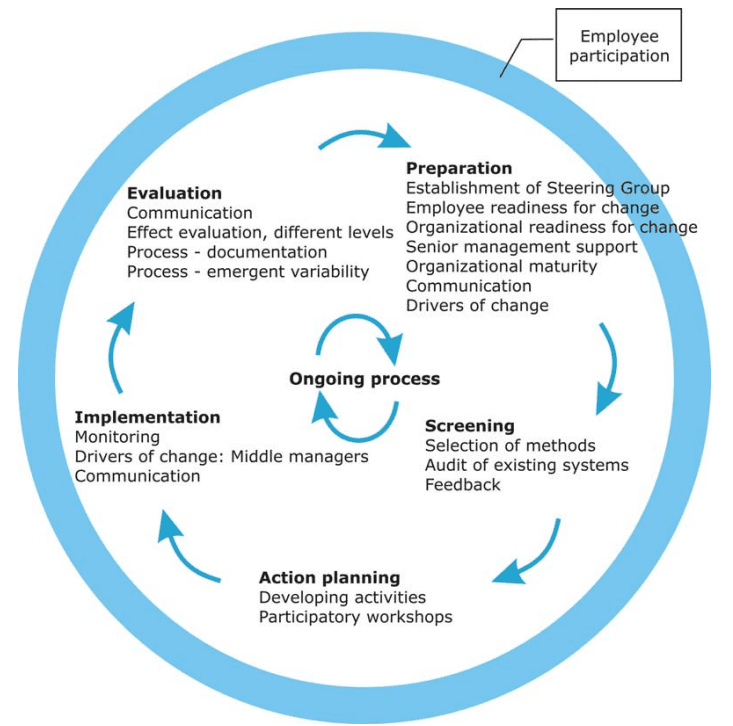Author: Katherine Ciarlante, PhD Student in Industrial-Organizational Psychology.
While the word “intervention” often makes people think of efforts to address drug and alcohol abuse or personal health issues, there is more to interventions than meets the eye. Interventions are important tools that can be used to create positive, lasting changes in employees and organizations.
What are occupational health interventions?
On a broad level, interventions can be understood as structured programs that work to produce changes in behaviors and attitudes, and ultimately lead to positive outcomes for organizations and their employees. Interventions can achieve these outcomes by reducing or eliminating job stressors (primary intervention), increasing employee resources (secondary intervention), or addressing the negative impact of stressors on employees including health issues (tertiary intervention). Occupational health interventions in particular are generally designed to alter the work environment in ways that improve the health, safety and well-being of employees. This is primarily done through changes to the way work is organized, designed, or managed within an organization.
What are the benefits of occupational health interventions?
Positive outcomes associated with occupational health interventions include direct improvements in employees’ mental health, physical well-being, and injury/illness rates. While the primary aim of organizational interventions tend to be the improvement of employee health and well-being, there is also a strong business case for implementing these programs. For example the return-on-investment for organizations is high as the benefits of many interventions include turnover, reduced absenteeism, and lower health care associated costs (Nielsen & Abildgaard, 2013). Additionally, happier and healthier employees may be more productive employees (Dejoy et al., 2010; Taris & Schreurs, 2009) resulting in tangible gains to performance outcomes post-intervention.
What does a typical occupational health intervention look like?
Occupational health interventions can take many forms, including work redesign, training, ergonomic programs, and behavioral health programs, and are intended to remove or modify the job stressors encountered by employees at work. While the specific forms of interventions may vary, the best, most effective, programs are those that directly target specific sources, rather than the symptoms, of job stress and encourage the direct participation of employees. Risk assessment techniques are used to assess, identify, and prioritize underlying work issues, so that interventions can be systematically designed to change or modify these factors in ways that improve organizational and employee outcomes. The complex nature of these programs also requires an understanding of the context in which the intervention occurs including existing organizational procedures and culture and organizational and employee readiness for change.
Occupational health interventions occur through a series of on-going planning, implementation, and evaluations phases such as those outlined in Nielson and colleagues (2010) model of occupational health interventions (see Figure 1). It is very important to remember that interventions are fluid, on-going, processes and that evaluating your organization and employees prior to intervention is essential for determining how to most effectively develop/implement your program and identifying whether significant positive change has occurred.

Figure 2. Model of occupational health interventions (Nielsen, Randall, Holten, & González, 2010)
What challenges can occupational health interventions address?
Interventions can be designed to address any number of issues in the workplace with the potential to negatively affect including those related to leadership, communication, interpersonal treatment, hours and scheduling, job demands, work tasks, employee attitudes (i.e., satisfaction, commitment), and employee safety. Occupational health interventions have been utilized to both prevent problems from happening, as well address problems when they occur. Much of the value of interventions comes from their flexibility! Interventions can be designed to include whichever strategies and activities best address the workplace issues and challenges impacting the specific hotel of interest.
While conducting an occupational health intervention in your organization may seem intimidating at first the benefits of occupational health interventions are large and can produce tangible positive change in your organization and employees. The TRT team has experience designing, implementing, and evaluating interventions across a range of industries and organizations and would love to make your organization our next partner. To contact the TRT program about potential projects and collaborations please contact us at (hyper link to contact page)
References
DeJoy, D. M., Wilson, M. G., Vandenberg, R. J., McGrath‐Higgins, A. L., & Griffin‐Blake, C. S. (2010). Assessing the impact of healthy work organization intervention. Journal of Occupational and Organizational Psychology, 83(1), 139-165.
Nielsen, K., & Abildgaard, J. S. (2013). Organizational interventions: A research-based framework for the evaluation of both process and effects. Work & Stress, 27(3), 278-297.
Nielsen, K., Randall, R., Holten, A. L., & González, E. R. (2010). Conducting organizational-level occupational health interventions: What works?. Work & Stress, 24(3), 234-259.
Taris, T. W., & Schreurs, P. J. (2009). Well-being and organizational performance: An organizational-level test of the happy-productive worker hypothesis. Work & Stress, 23(2), 120-136.

For more questions about the Sunshine Education and Research Center and the Targeted Research Training Program, please contact Dr. Mindy Shoss at targetedresearch@ucf.edu.